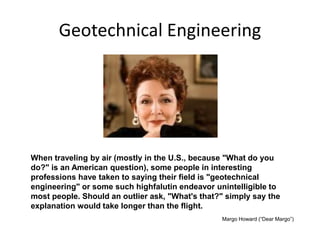Geotheta Can Be Fun For Anyone
Wiki Article
Geotheta Can Be Fun For Everyone
Table of ContentsThe Main Principles Of Geotheta The Definitive Guide to GeothetaIndicators on Geotheta You Need To Know3 Simple Techniques For GeothetaIndicators on Geotheta You Should Know

They perform website investigations, gather examples, perform research laboratory tests, and analyze information to examine the viability of the ground for building tasks - Consulting Engineer. Based upon their searchings for, geotechnical engineers give suggestions for structure design, slope stability, preserving frameworks, and mitigation of geotechnical risks. They collaborate with various other professionals, such as engineers, structural engineers, and construction groups, to make sure that geotechnical factors to consider are incorporated right into the total task style and execution
By evaluating the behavior and properties of soil and rock, they can determine possible geotechnical dangers such as landslides, dirt negotiation, or slope instability. Their proficiency helps avoid failings or mishaps that might threaten lives and residential property. Here are some detailed tasks and responsibilities of a geotechnical designer: Site Examination: Geotechnical engineers conduct site examinations to collect information on subsurface problems.
They interpret the information to understand the residential properties and actions of the dirt and rock, including their stamina, leaks in the structure, compaction qualities, and groundwater conditions. Geotechnical Evaluation and Design: Geotechnical engineers examine the data gathered throughout site investigations to analyze the stability and viability of the website for construction jobs. They do geotechnical estimations and modeling to evaluate variables such as bearing capability, settlement, incline stability, lateral planet stress, and groundwater flow.
Some Ideas on Geotheta You Should Know
Foundation Layout: Geotechnical designers play a critical duty in creating foundations that can securely support the desired structure. They assess the soil conditions and load demands to determine the appropriate foundation type, such as shallow structures (e.g., footings), deep structures (e.g (https://www.provenexpert.com/geotheta/)., stacks), or specialized strategies like dirt enhancement. They consider factors such as settlement restrictions, bearing capability, and soil-structure interaction to develop ideal foundation designsThey examine building plans, screen site activities, and carry out area assessments to confirm that the layout recommendations are adhered to. If unpredicted geotechnical concerns occur, they analyze the situation and provide referrals for removal or adjustments to the layout. Threat Assessment and Reduction: Geotechnical designers examine geotechnical risks and threats linked with the task site, such as landslides, liquefaction, or soil erosion.

Cooperation and Interaction: Geotechnical designers work carefully with various other experts entailed in a job, such as engineers, architectural designers, and construction groups. Efficient interaction and cooperation are vital to integrate geotechnical considerations right into the general job style and construction process. Geotechnical designers offer technological competence, response questions, and make sure that geotechnical needs are satisfied.
The Of Geotheta
Here are some types of geotechnical designers: Structure Designer: Foundation designers specialize in designing and assessing structures for structures. They analyze the soil problems, lots requirements, and site features to figure out one of the most appropriate foundation type and layout, such as shallow foundations, deep structures, or specialized techniques like stack foundations.They evaluate the aspects affecting slope stability, such as soil residential or commercial properties, groundwater conditions, and incline geometry, and create strategies to stop slope failings and reduce threats. Quake Engineer: Earthquake engineers concentrate on evaluating and making frameworks to stand up to seismic forces. They evaluate the seismic danger of a site, review soil liquefaction potential, and develop seismic style standards to guarantee the safety and security and strength of frameworks during earthquakes.
They execute field testing, collect samples, and examine the gathered data to define the soil buildings, geologic formations, and groundwater problems at a website. Geotechnical Instrumentation Designer: Geotechnical instrumentation designers concentrate on tracking and measuring the behavior of soil, rock, and structures. They mount and preserve instrumentation systems that keep track of factors such as soil negotiation, groundwater degrees, slope movements, and architectural variations to analyze performance and offer very early cautions of possible problems.
10 Simple Techniques For Geotheta
They carry out tests such as triaxial tests, debt consolidation examinations, direct shear tests, and leaks in the structure tests to collect data for geotechnical evaluation and design. Geosynthetics Engineer: Geosynthetics designers specialize in the design and application of geosynthetic materials, such as geotextiles, geogrids, and geomembranes. They utilize these products to improve soil security, reinforce inclines, provide water drainage remedies, and control erosion.They have a tendency to be investigatory individuals, which suggests they're intellectual, introspective, and curious. They are interested, systematic, rational, analytical, and rational. Some of them are also social, implying they're kind, generous, cooperative, patient, caring, handy, compassionate, sensible, and pleasant - Tailings Engineer.
In the workplace atmosphere, geotechnical engineers use specialized software program devices to execute calculations, create designs, and examine information. They prepare records, review task requirements, connect with customers and team members, and More hints coordinate task activities. The workplace setup provides a conducive setting for research, analysis, and collaboration with other specialists entailed in the task.
Excitement About Geotheta
They regularly go to job websites to conduct website investigations, evaluate geotechnical conditions, and collect information for evaluation. These brows through entail taking a trip to different locations, often in remote or tough terrains. Geotechnical designers might carry out soil sampling, conduct tests, and monitor building activities to make sure that the geotechnical aspects of the task are being carried out correctly.Geotechnical engineers additionally function in specialized geotechnical research laboratories. Geotechnical laboratory engineers function thoroughly in these environments, handling testing devices, operating instruments, and tape-recording information.
Report this wiki page